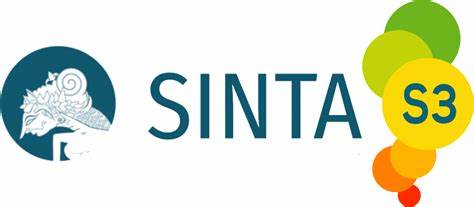INTRODUCING WORLD ENGLISHES: A CASE STUDY OF AN INDONESIAN EFL LISTENING CLASSROOM
Abstract
English has established itself as a global language, playing a central role in international communication, education, business, and technology across diverse cultural and linguistic contexts. However, despite this development, studies about the introduction of World Englishes in the EFL listening classroom are still insufficient. This qualitative case study aims to find out about a lecturer’s view, the perceived benefits and challenges in the context of introducing World Englishes in EFL listening class. This case study explores a lecturer’s EFL listening class of a West Java university who has long integrated World Englishes. Data were collected through five open-ended questionnaires, five interview questions, and eight recorded sessions analyzed using an observation sheet and thematic analysis. This study reveals the lecturer’s positive views toward World Englishes. The study also found the lecturer’s consistency in introducing World Englishes and the increased cultural understanding, increased confidence in listening, and readiness in facing diverse real-world English varieties. Despite these benefits, some challenges were encountered, such as native speakerism views and challenges in adjusting the practice to fit the allocated time. The findings supported the idea that introducing World Englishes is the best practice to prepare students for diverse English variants used in this globalized world.
References
Ahn, H. (2015). Awareness of and attitudes to Asian englishes: A study of english teachers in South Korea. Asian Englishes, 17(2), 132–151. https://doi.org/10.1080/13488678.2015.1036602
Aykut-Kolay, C. (2022). English Language Teaching (ELT) students’ attitudes towards World Englishes (WE): Insights from Turkey. Journal of Language and Education Review, 2022(2), 12–25.
Barella, Y., & Linarsih, A. (2020). Extensive listening practice in EFL classroom with variety of news websites. Pedagogy : Journal of English Language Teaching, 8(1), 43. https://doi.org/10.32332/pedagogy.v8i1.1961
Bhowmik, S. K. (2015). World Englishes and English language teaching: A pragmatic and humanistic approach. Colombian Applied Linguistics Journal, 17(1), 142. https://doi.org/10.14483/udistrital.jour.calj.2015.1.a10
Boonsuk, Y., Ambele, E. A., & McKinley, J. (2021). Developing awareness of global englishes: Moving away from ‘native standards’ for Thai University ELT. System, 99, 102511. https://doi.org/10.1016/j.system.2021.102511
Braun, V., & Clarke, V. (2006). Using thematic analysis in psychology. Qualitative Research in Psychology, 3(2), 77–101. https://doi.org/10.1191/1478088706qp063oa
Ceyhan-Bingöl, Z., & Özkan, Y. (2019). EFL Instructors’ Perceptions and Practices on English as a Lingua Franca (ELF). The Reading Matrix: An International Online Journal, 19(2), 86–102.
Chang, A., Millett, S., & Renandya, W. A. (2019). Developing Listening Fluency through Supported Extensive Listening Practice. RELC Journal, 50(3), 422–438. https://doi.org/10.1177/0033688217751468
Creswell, J. W. (2018). Educational research: Planning, conducting, and evaluating quantitative and qualitative research, fourth edition John Creswell. Pearson Education.
Deardorff, D. K. (2006). Identification and assessment of intercultural competence as a student outcome of Internationalization. Journal of Studies in International Education, 10(3), 241–266. https://doi.org/10.1177/1028315306287002
Dörnyei, Z., & Dewaele, J.-M. (2022). Questionnaires in Second language research. Questionnaires in Second Language Research, 3–13. https://doi.org/10.4324/9781003331926-2
Fang, F. (Gabriel), & Ren, W. (2018). Developing students’ awareness of Global Englishes. ELT Journal, 72(4), 384–394. https://doi.org/10.1093/elt/ccy012
Fang, F. (Gabriel) (2016). Investigating attitudes towards English accents from an ELF framework. The Asian Journal of Applied Linguistics, 3(1).
Galloway, N. (2013). Global Englishes and English language teaching (ELT) – bridging the gap between theory and practice in a Japanese context. System, 41(3), 786–803. https://doi.org/10.1016/j.system.2013.07.019
Galloway, N., & Rose, H. (2017). Incorporating global englishes into the ELT classroom. ELT Journal, 72(1), 3–14. https://doi.org/10.1093/elt/ccx010
Galloway, N., & Rose, H. (2015). Introducing global englishes. Routledge.
Gill, S. K., & Kirkpatrick, A. (2012). English in Asian and european higher education. The Encyclopedia of Applied Linguistics. https://doi.org/10.1002/9781405198431.wbeal0383
Harsanti, H. R., & Manara, C. (2021). “I have to teach the ‘english’ English”: Native-speakerism ideology among the English teachers. Indonesian Journal of Applied Linguistics, 11(2). https://doi.org/10.17509/ijal.v11i2.26379
Hutz, M. (2022). Integrating linguistic diversity into English language teaching. Pluricentric Languages and Language Education, 25–40. https://doi.org/10.4324/9781003248552-4
Jenkins, J. (2006). Current perspectives on teaching world Englishes and English as a lingua franca. TESOL Quarterly, 40(1), 157–181.
Jenkins, J. (2014). Global Englishes. https://doi.org/10.4324/9781315761596
Jeong, H., Elgemark, A., & Thorén, B. (2021). Swedish youths as listeners of Global Englishes speakers with diverse accents: Listener intelligibility, listener comprehensibility, accentedness perception, and accentedness acceptance. Frontiers in Education, 6. https://doi.org/10.3389/feduc.2021.651908
Kachru, B. B. (1986). The alchemy of English the spread, functions, and models of non-native Englishes Braj B. Kachru. Pergamon Inst. of English. Pergamon Press.
Kim, D. (2020). Learning language, learning culture: Teaching language to the whole student. ECNU Review of Education, 3(3), 519–541. https://doi.org/10.1177/2096531120936693
Kirkpatrick, A. (2021). Teaching (about) world englishes and English as a lingua franca. Research Developments in World Englishes. https://doi.org/10.5040/9781350167087.ch-012
Krashen, S. D. (2006). The Input Hypothesis: Issues and implications. Crane Resource Centre.
Lee, E. S., & Ahn, H. (2020). Overseas Singaporean attitudes towards Singlish. Asian Englishes, 23(3), 264–279. https://doi.org/10.1080/13488678.2020.1795783
Lee, K.-Y. (2012). Teaching intercultural English learning/teaching in world Englishes: Some classroom activities in South Korea. English Teaching: Practice and Critique, 11(4).
Liu, H., Zhang, X., & Fang, F. (2021). Young english learners’ attitudes towards China English: Unpacking their identity construction with implications for secondary level language education in China. Asia Pacific Journal of Education, 43(1), 283–298. https://doi.org/10.1080/02188791.2021.1908228
Matsuda, A. (2003). Incorporating World Englishes in teaching English as an international language. TESOL Quarterly, 37(4), 719. https://doi.org/10.2307/3588220
Mauranen, A. (2018). Second language acquisition, World Englishes, and English as a lingua franca (ELF). World Englishes, 37(1), 106–119. https://doi.org/10.1111/weng.12306
Mishra, S., & Dey, A. K. (2022). Understanding and identifying ‘themes’ in qualitative case study research. South Asian Journal of Business and Management Cases, 11(3), 187–192. https://doi.org/10.1177/22779779221134659
Pan, H., Liu, C., Fang, F., & Elyas, T. (2021). “how is my English?”: Chinese University Students’ attitudes toward China English and their identity construction. SAGE Open, 11(3), 215824402110382. https://doi.org/10.1177/21582440211038271
Prabjandee, D. (2019). Teacher professional development to implement Global Englishes Language teaching. Asian Englishes, 22(1), 52–67. https://doi.org/10.1080/13488678.2019.1624931
Rahmatillah, R., Rahma, E. A., Jakfar, A. E., & Oktavinanda, G. (2022). Current challenges and benefits of Teaching World Englishes. EnJourMe (English Journal of Merdeka) : Culture, Language, and Teaching of English, 7(1), 94–101. https://doi.org/10.26905/enjourme.v7i1.7827
Raja, P., Flora, Putrawan, G. E., & Razali, A. B. (2022). English as an international language: Perceptions of EFL preservice teachers in higher education institutions in Indonesia. Education Research International, 2022, 1–8. https://doi.org/10.1155/2022/3234983
Renandya, W. A., & Farrell, T. S. (2010). “teacher, the tape is too fast!” extensive listening in elt. ELT Journal, 65(1), 52–59. https://doi.org/10.1093/elt/ccq015
Rose, H., McKinley, J., & Galloway, N. (2020). Global Englishes and language teaching: A review of pedagogical research. Language Teaching, 54(2), 157–189. https://doi.org/10.1017/s0261444820000518
Sadeghpour, M., & D’Angelo, J. (2022). World Englishes and ‘global englishes’: Competing or complementary paradigms? Asian Englishes, 24(2), 211–221. https://doi.org/10.1080/13488678.2022.2076368
Schildhauer, P., Schulte, M., & Zehne, C. (2020). Global Englishes in the Classroom From Theory to Practice. Zeitschrift Für Schul- Und Professionsentwicklung, 2(4). https://doi.org/https://doi.org/10.4119/pflb-3435
Snodin, N. S., & Young, T. J. (2015). ‘native-speaker’ varieties of English: Thai perceptions and attitudes. Asian Englishes, 17(3), 248–260. https://doi.org/10.1080/13488678.2015.1083354
Suminar, R., & Gunawan, M. H. (2024). WORLD ENGLISHES IN ENGLISH LANGUAGE TEACHING (ELT): STUDENTS’ PERCEPTIONS. ELTIN JOURNAL: Journal of English Language Teaching in Indonesia, 12(2).
Tarrayo, V. N., Ulla, M. B., & Lekwilai, P. (2020). Does Thai English exist? voices from English language teachers in two Thai universities. Asian Englishes, 23(3), 280–293. https://doi.org/10.1080/13488678.2020.1821299
Tsang, A. (2019). Reconceptualizing speaking, listening, and pronunciation: Glocalizing tesol in the contexts of World Englishes and English as a lingua franca. TESOL Quarterly, 53(2), 580–588. https://doi.org/10.1002/tesq.504
Ubaidillah, M. F., Elfiyanto, S., Rifiyani, A. J., & Lee, H. Y. (2023). Indonesian EFL teachers’ identity construction in a Global Englishes Era. JEELS (Journal of English Education and Linguistics Studies), 10(1), 199–235. https://doi.org/10.30762/jeels.v10i1.1082
Yin, R. K., & Campbell, D. T. (2018). Case study research and applications: Design and methods. SAGE Publications, Inc.
Downloads
Published
Issue
Section
License

This work is licensed under a Creative Commons Attribution-ShareAlike 4.0 International License.
The author is responsible for acquiring the permission(s) to reproduce any copyrighted figures, tables, data, or text that are being used in the submitted paper. Authors should note that text quotations of more than 250 words from a published or copyrighted work will require grant of permission from the original publisher to reprint. The written permission letter(s) must be submitted together with the manuscript.




